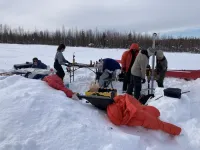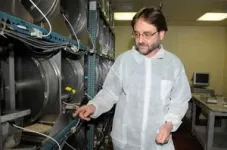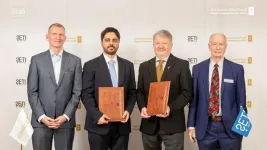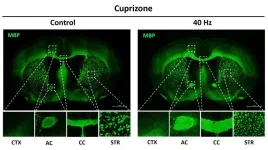(Press-News.org) When Katey Walter Anthony heard rumors of methane, a potent greenhouse gas, ballooning under the lawns of fellow Fairbanks residents, she nearly didn’t believe it.
“I ignored it for years because I thought ‘I am a limnologist, methane is in lakes,’” she said.
But when a local reporter contacted Walter Anthony, who is a research professor at the Institute of Northern Engineering at University of Alaska Fairbanks, to inspect the waterbed-like ground at a nearby golf course, she started to pay attention. Like others in Fairbanks, they lit “turf bubbles” on fire and confirmed the presence of methane gas.
Then, when Walter Anthony looked at nearby sites, she was shocked that methane wasn’t just coming out of a grassland. “I went through the forest, the birch trees and the spruce trees, and there was methane gas coming out of the ground in large, strong streams,” she said.
“We just had to study that more,” Walter Anthony said.
With funding from the National Science Foundation, she and her colleagues launched a comprehensive survey of dryland ecosystems in Interior and Arctic Alaska to determine whether it was a one-off oddity or unforeseen concern.
Their study, published in the journal Nature Communications this July, reported that upland landscapes were releasing some of the highest methane emissions yet documented among northern terrestrial ecosystems. Even more, the methane consisted of carbon thousands of years older than what researchers had previously seen from upland environments.
“It’s a totally different paradigm from the way anyone thinks about methane,” Walter Anthony said.
Because methane is 25 to 34 times more potent than carbon dioxide, the discovery brings new concerns to the potential for permafrost thaw to accelerate global climate change.
The findings challenge current climate models, which predict that these environments will be an insignificant source of methane or even a sink as the Arctic warms.
Typically, methane emissions are associated with wetlands, where low oxygen levels in water-saturated soils favor microbes that produce the gas. Yet methane emissions at the study’s well-drained, drier sites were in some cases higher than those measured in wetlands.
This was especially true for winter emissions, which were five times higher at some sites than emissions from northern wetlands.
Digging into the source
“I needed to prove to myself and everyone else that this is not a golf course thing,” Walter Anthony said.
She and colleagues identified 25 additional sites across Alaska’s dry upland forests, grasslands and tundra and measured methane flux at over 1,200 locations year-round across three years. The sites encompassed areas with high silt and ice content in their soils and signs of permafrost thaw known as thermokarst mounds, where thawing ground ice causes some parts of the land to sink. This leaves behind an “egg carton” like pattern of conical hills and sunken trenches.
The researchers found all but three sites were emitting methane.
The research team, which included scientists at UAF’s Institute of Arctic Biology and the Geophysical Institute, combined flux measurements with an array of research techniques, including radiocarbon dating, geophysical measurements, microbial genetics and directly drilling into soils.
They found that unique formations known as taliks, where deep, expansive pockets of buried soil remain unfrozen year-round, were likely responsible for the elevated methane releases.
These warm winter havens allow soil microbes to stay active, decomposing and respiring carbon during a season that they normally wouldn’t be contributing to carbon emissions.
Walter Anthony said that upland taliks have been an emerging concern for scientists because of their potential to increase permafrost carbon emissions. “But everyone's been thinking about the associated carbon dioxide release, not methane,” she said.
The research team emphasized that methane emissions are especially high for sites with Pleistocene-era Yedoma deposits. These soils contain large stocks of carbon that extend tens of meters below the ground surface. Walter Anthony suspects that their high silt content prevents oxygen from reaching deeply thawed soils in taliks, which in turn favors microbes that produce methane.
Walter Anthony said it’s these carbon-rich deposits that make their new discovery a global concern. Even though Yedoma soils only cover 3% of the permafrost region, they contain over 25% of the total carbon stored in northern permafrost soils.
The study also found through remote sensing and numerical modeling that thermokarst mounds are developing across the pan-Arctic Yedoma domain. Their taliks are projected to be formed extensively by the 22nd century with continued Arctic warming.
“Everywhere you have upland Yedoma that forms a talik, we can expect a strong source of methane, especially in the winter,” Walter Anthony said.
“It means the permafrost carbon feedback is going to be a lot bigger this century than anybody thought,” she said.
END
Researchers find unexpectedly large methane source in overlooked landscape
2024-08-08
ELSE PRESS RELEASES FROM THIS DATE:
Royal Commission for AlUla collaborates with SETI Institute to support development of Alula Manara Observatory
2024-08-08
Royal Commission for AlUla Collaborates with SETI Institute to Support Development of AlUla Manara Observatory
Experts from SETI Institute will support the advancement of telescope technology and data analysis at AlUla Manara Observatory.
The collaboration will enhance the future observatory's capabilities as it welcomes global scientists, researchers, and tourists interested in astronomy and space science.
Ambitions to foster curiosity, knowledge sharing, and upskilling local capabilities in astronomical and space sciences field
Mountain View, CA , 8 August 2024 -- The Royal Commission for AlUla (RCU) and SETI Institute ...
Cutting a few calories won’t hurt your workout
2024-08-08
A new UC Riverside study demonstrates that calorie restriction doesn’t deter mice from exercising, challenging the belief that dieting drains workout energy.
The study, published in the journal Physiology & Behavior, shows that cutting calories by 20% did not significantly reduce the distance that mice voluntarily chose to run each day.
The researchers set out to understand what happens to mice when the amount of food available to them is reduced. The findings, they hoped, would be relevant ...
Study reveals ways in which 40Hz sensory stimulation may preserve brain’s ‘white matter’
2024-08-08
Early-stage trials in Alzheimer’s disease patients and studies in mouse models of the disease have suggested positive impacts on pathology and symptoms from exposure to light and sound presented at the “gamma” band frequency of 40 Hz. A new study zeroes in on how 40Hz sensory stimulation helps to sustain an essential process in which the signal-sending branches of neurons, called axons, are wrapped in a fatty insulation called myelin. Often called the brain’s “white matter,” myelin protects axons and insures better ...
Record-breaking recovery of rocks that originated in Earth’s mantle could reveal secrets of planet’s history
2024-08-08
Scientists have recovered the first long section of rocks that originated in the Earth’s mantle, the layer below the crust and the planet’s largest component.
The rocks will help unravel the mantle’s role in the origins of life on Earth, the volcanic activity generated when it melts, and how it drives the global cycles of important elements such as carbon and hydrogen, according to the team.
The nearly continuous 1,268 metres of mantle rock was recovered from a “tectonic window,” a section ...
Surprise: infected bacteria fight back with “hidden” genes that halt cell growth, slow viral spread
2024-08-08
Researchers have uncovered a surprising way bacteria defend themselves: when a bacterium is infected, bacterial enzymes that copy genetic information from RNA into DNA synthesize genes whose protein products help shut down cell growth. This prevents further viral spread in the neighboring bacterial population. The results highlight the potential for other “hidden” genes, like the one found here, to be unearthed in different biological contexts. Bacteria defend themselves from viral ...
Early prenatal exposure to famine increases Type 2 diabetes risk in adulthood, shows study of historical Ukraine event
2024-08-08
Prenatal exposure to famine significantly increases the risk of developing Type 2 diabetes mellitus (T2DM) in adulthood, according to a new study of people impacted by the 1932-1933 Holodomor famine in Ukraine. While the immediate and short-term effects of famines on mortality and morbidity are well-documented, deciphering famines’ long-term health consequences – as this study did – has been more difficult. Previous research has suggested a link between prenatal nutrition and adult health ...
Marine algae use massive enzymes of unprecedented size to biosynthesize fish-killing toxins
2024-08-08
Marine algae Prymnesium parvum use massive enzymes dubbed PKZILLAs – some of the largest proteins ever to be identified in nature – to make large and complex prymnesin neurotoxins responsible for mass fish kills during harmful algal blooms worldwide, researchers report. “The discovery and initial characterization of the prymnesin PKZILLA gigasynthases now elucidates the long-standing question about how microalgae biosynthesize their giant polyketide polyether molecules,” write the authors. It also expands ...
Record-breaking 1.2-kilometer drill core unveils new insights into Earth's mantle
2024-08-08
A record-breaking 1268-meter drill core into Earth’s mantle, collected from the Mid-Atlantic Ridge in the North Atlantic, has provided a deep and detailed mineralogical glimpse of the oceanic mantle. The findings reveal new insights into mantle composition, Earth’s deep geology, and the potential biogeochemical conditions involved in the origins of life. Understanding the Earth’s mantle is crucial for comprehending important details of the Earth system, including terrestrial magmatism, crust formation, and the cycling ...
American College of Cardiology issues guide for managing in-patient heart failure
2024-08-08
The American College of Cardiology has issued updated guidance on managing patients hospitalized for heart failure (HF) to provide a decision-making pathway that tailors therapy to clinical trajectory to better manage disease. The updated Expert Consensus Decision Pathway incorporates the latest evidence to provide guidance for clinicians to use at the point of care in conjunction with the 2022 ACC/AHA Heart Failure Guideline.
Heart failure refers to several conditions that can affect the way the heart works, its structure or both. Over time, heart failure makes ...
Type 2 diabetes cases more than doubled seven decades after exposure to famine
2024-08-08
Researchers at Columbia University Mailman School of Public Health, the University of North Carolina at Chapel Hill and at the National Academy of Sciences of Ukraine used the setting of the man-made Ukrainian Holodomor famine of 1932-1933 to examine the relation between prenatal famine and adult Type 2 diabetes mellitus (T2DM). They studied 128,225 Type 2 diabetes cases diagnosed between 2000-2008 among 10,186,016 male and female Ukrainians born between 1930 and 1938.
Individuals who were exposed in early gestation to the famine had a more than two-fold likelihood of developing Type 2 diabetes compared to those ...





